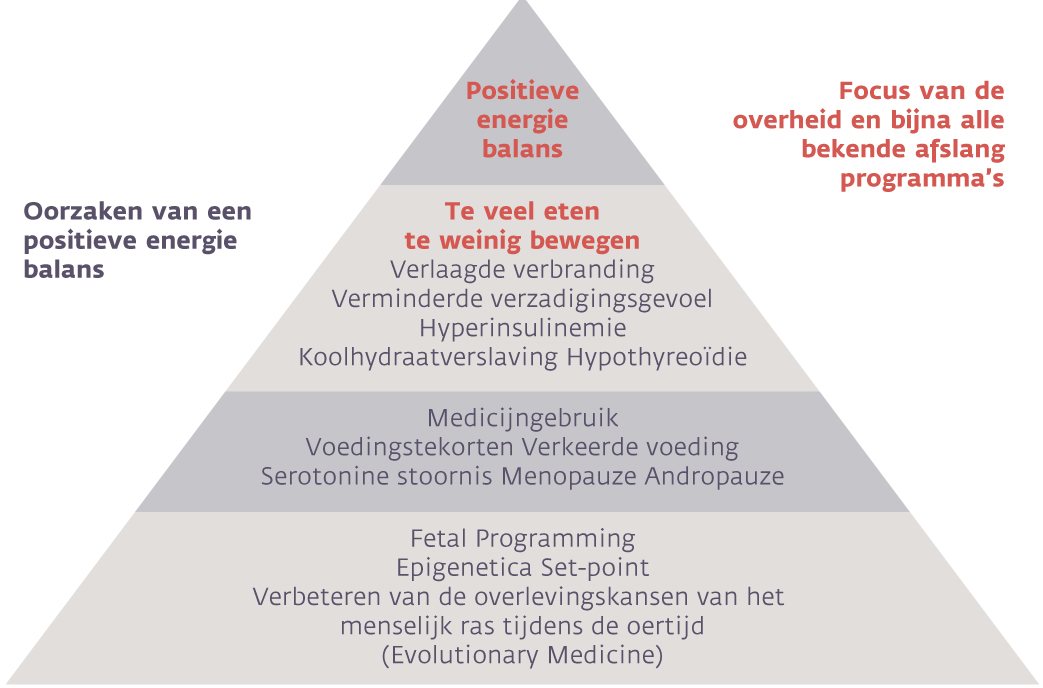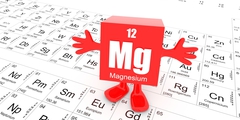
Deel 1 | Lichamelijke oorzaken van overgewicht
Herken de oorzaken die succesvol afvallen in de weg kunnen staan
Je zou toch heel raar staan te kijken als je bij de huisarts binnenkwam en je arts zei, nog voor je ging zitten: 'U krijgt van mij een ontstekingsremmer', zonder eerst te onderzoeken wat er met jou aan de hand is. Toch gebeurt dit al tientallen jaren bij de behandeling van overgewicht. Er wordt een dieet en een bewegingsadvies gegeven zonder rekening te houden met de mogelijke andere oorzaken van gewichtstoename. In dit eerste deel van deze serie kun je lezen hoe je deze 'andere oorzaken' van overgewicht op een eenvoudige manier kunt herkennen.
Beste bezoeker, u heeft geen toegang.
Enkel (web)abonnees hebben toegang tot tijdschriftartikelen. Het webabonnement is nog in de maak.
U kunt zich wel alvast (gratis) registreren en tal van andere webartikelen raadplegen!
Auteur
Trefwoorden:
Verschenen in
Referenties
- VWS Nota overgewicht 23 maart 2009
Als mensen minder eten én meer bewegen, stopt vanzelf de toename van hun gewicht. Article - CBS STATLINE16 maart 2010 Personen ouder dan 12 jaar die voldoen aan de norm gezond bewegen Article
- CBS STATLINE16 maart 2010 Overgewicht (BMI > 25) bij personen ouder dan 20 jaar Article
- CBS STATLINE16 maart 2010 Ernstig overgewicht (BMI < 30) bij personen ouder dan 20 jaar Article
- CBS STATLINE16 maart 2010 Overgewicht bij kinderen tussen de 2 20 jaar Article
- Greenwood JL, Stanford JB. J Am Board Fam Med. 2008 Mar-Apr;21(2):135-40 Preventing or improving obesity by addressing specific eating patterns
Weight is a product of energy balance: energy intake versus energy expenditure.Article - Olivieri O, Girelli D, Stanzial AM, Rossi L, Bassi A, Corrocher R.Biol Trace Elem Res. 1996 Jan;51(1):31-41. Selenium, zinc, and thyroid hormones in healthy subjects: low T3/T4 ratio in the elderly is related to impaired selenium status
The structure of nuclear thyroid hormone receptors contains Zinc (Zn) ions, crucial for the functional properties of the protein. Iodothyronine 5' deiodinase, which is mainly responsible for peripheral T3 production, has recently been demonstrated to be a selenium (Se)-containing enzyme. A highly significant linear correlation between the T3/T4 ratio and indices of Se status was observed in the older group of subjects. Abstract - Wu HY, Xia YM, Chen XS., Sheng Li Ke Xue Jin Zhan. 1995 Jan;26(1):12-6. Selenium deficiency and thyroid hormone metabolism and function
If Se is deficient, the deiodinase activity would be inhibited, the level of circulation T4 will be elevated, and the concentration T3 in peripheral tissues will be decreased. Se deficiency will also accelerate the iodine depletion of thyroid and may even exacerbate some detrimental effects of iodine deficiency. Possibly Se deficiency is involved in the occurrence and development of iodine deficient disorders. Keshan disease, with Se deficiency as the major cause, was also observed a change of thyroid hormone metabolism Abstract - Miniero R, D'Archivio M, Olivieri A, De Angelis S, Sorcini M. Ann Ist Super Sanita. 1998;34(3):349-55. Effects of the combined deficiency of selenium and iodine on thyroid function
In fact, although the major role of selenium is related to the glutathione peroxidase system, which protects cellular structures from oxidative damages, selenium plays also an important role in thyroid hormone metabolism as an essential component of the three deiodinase Abstract - Laurberg P, Cerqueira C, Ovesen L, Rasmussen LB, Perrild H, Andersen S, Pedersen IB, Carlé A. Best Pract Res Clin Endocrinol Metab. 2010 Feb;24(1):13-27. Iodine intake as a determinant of thyroid disorders in populations
Both iodine intake levels below and above the recommended interval are associated with an increase in the risk of disease in the population. Abstract - Alemany M. Prog Food Nutr Sci. 1989;13(1):45-66. The etiologic basis for the classification of obesity
The physiologic and metabolic pathways responsible of the appearance of obesity are revisited, as well as the current theories on body weight regulatory mechanisms. From this information, a classification of obesities is proposed: 1) Hypothalamic, 2) Bulimic, 3) Digestive, 4) Hyperinsulinemic, 5) Hypothermogenic, 6) Hypothyroid, and 7) Set point. These conditions should not be treated therapeutically in the same way, as the causes of development of the illness are not equal. The need to determine the individualized causes of obesity prior to any treatment is stressed.Abstract - Dhillo WS, Bloom SR. Horm Metab Res. 2004 Nov-Dec;36(11-12):846-51 Gastrointestinal hormones and regulation of food intake (PubMed 15655718)
Several peptides synthesised in the gastrointestinal tract which affect food intake have been identified including ghrelin, cholecystokinin (CCK), glucagon-like peptide-1 (7-36) amide (GLP-1), oxyntomodulin, peptide YY (PYY) and pancreatic polypeptide (PP). Abstract - Sahu A. Front Neuroendocrinol. 2003 Dec;24(4):225-53 Leptin signaling in the hypothalamus: emphasis on energy homeostasis and leptin resistance
Leptin, the long-sought factor of adipocytes origin, has emerged as one of the major signals that relay the status of fat stores to the hypothalamus and plays a significant role in energy homeostasis. It is now established that central leptin resistance contributes to the development of diet-induced obesity and ageing associated obesity. Abstract - Huda MS, Wilding JP, Pinkney JH. Obes Rev. 2006 May;7(2):163-82 Gut peptides and the regulation of appetite
In the last 10 years, discoveries of new hormones such as leptin and ghrelin, together with greater understanding of previously described hormones such as cholecystokinin (CCK), pancreatic polypeptide (PP), peptide YY (PYY) and glucagon-like peptide 1 (GLP-1), have led to a rapid increase in our knowledge of the regulation of energy balance. Among the most important factors, controlling appetite and satiety are peptide hormones released from the gut. Abstract - Chaudhri O, Small C, Bloom S. Philos Trans R Soc Lond B Biol Sci. 2006 Jul 29;361(1471):1187-209. Gastrointestinal hormones regulating appetite
Many gut peptides have been shown to influence energy intake. The most well studied in this regard are cholecystokinin (CCK), pancreatic polypeptide, peptide YY, glucagon-like peptide-1 (GLP-1), oxyntomodulin and ghrelin. With the exception of ghrelin, these hormones act to increase satiety and decrease food intake. Local effects such as the inhibition of gastric emptying might contribute to the decrease in energy intake. Circulating gut hormones have also been shown to act directly on neurons in hypothalamic and brainstem centres of appetite control. In this way, hormonal signals from the gut may be translated into the subjective sensation of satiety Article - De Vriese C, Delporte C. Curr Opin Clin Nutr Metab Care. 2007 Sep;10(5):615-9 Influence of ghrelin on food intake and energy homeostasis
Ghrelin is an endogenous orexigenic peptide recently discovered in the stomach. Ghrelin is involved in short-term regulation of food intake since its plasma levels increase before meals and decrease strongly postprandially Abstract - Foster-Schubert KE, McTiernan A, Frayo RS, Schwartz RS, Rajan KB, Yasui Y, Tworoger SS, Cummings DE. J Clin Endocrinol Metab. 2005 Feb;90(2):820-5. Epub 2004 Dec 7 Human plasma ghrelin levels increase during a one-year exercise program
Weight loss resulting from decreased caloric intake raises levels of the orexigenic hormone, ghrelin. In summary, ghrelin levels increase with weight loss achieved without reduced food intake, consistent with a role for ghrelin in the adaptive response constraining weight loss and, thus, in long-term body weight regulation.Abstract - Leidy HJ, Gardner JK, Frye BR, Snook ML, Schuchert MK, Richard EL, Williams NI. J Clin Endocrinol Metab. 2004 Jun;89(6):2659-64 Circulating ghrelin is sensitive to changes in body weight during a diet and exercise program in normal-weight young women
Body fat, body weight, and resting metabolic rate significantly decreased in the weight-loss group before the increase in ghrelin. These findings suggest that ghrelin responds in a compensatory manner to changes in energy homeostasis in healthy young women, and that ghrelin exhibits particular sensitivity to changes in body weight. Article - Romon M, Gomila S, Hincker P, Soudan B, Dallongeville J. J Clin Endocrinol Metab. 2006 Mar;91(3):1034-41. Epub 2005 Dec 29 Influence of weight loss on plasma ghrelin responses to high-fat and high-carbohydrate test meals in obese women
Diet-induced weight loss is associated with an increase in fasting ghrelin. Weight loss is associated with an improved postprandial plasma ghrelin response to a carbohydrate meal, whereas the response to a fat meal is not modified. Abstract - Erlanson-Albertsson C. Acta Paediatr Suppl. 2005 Jun;94(448):40-1. Appetite regulation and energy balance
Thirty minutes after the start of eating, satiety signals arise from the intestinal tract and, in between meals, from the adipose tissue and liver. Satiety signals are sedative and arrest the processing of food in the intestine, hence leading to termination of eating.Abstract - Goldstone AP. Prog Brain Res. 2006;153:57-73 The hypothalamus, hormones, and hunger: alterations in human obesity and illness
While obese subjects have appropriate reductions in orexigenic ghrelin, other gut-hormone disturbances may contribute to obesity such as reduced anorexigenic PYY and PP. Abstract - Small CJ, Bloom SR. Curr Drug Targets CNS Neurol Disord. 2004 Oct;3(5):379-88 Gut hormones as peripheral anti obesity targets
Obese subjects have lower basal fasting PYY levels and have a smaller post prandial rise. Abstract - Zwirska-Korczala K, Konturek SJ, Sodowski M, Wylezol M, Kuka D, Sowa P, Adamczyk-Sowa M, Kukla M, Berdowska A, Rehfeld JF, Bielanski W, Brzozowski T. J Physiol Pharmacol. 2007 Mar;58 Suppl 1:13-35. Basal and postprandial plasma levels of PYY, ghrelin, cholecystokinin, gastrin and insulin in women with moderate and morbid obesity and metabolic syndrome
In MOB-MS women the fasting PYY(3-36) levels were lower compared to lean controls and OB-MS, whilst postprandially in both OB-MS and MOB-MS, it was much lower than in lean women Article - Stasiuniene N, Praskevicius A. Medicina (Kaunas). 2005;41(12):989-1001 Peptides regulating food intake and body weight
So, adipocytes synthesize and express leptin, the product of Ob gene, a regulator of long-term food intake, in amounts proportional to the fat amount Abstract - Scarpace PJ, Zhang Y. Front Biosci. 2007 May 1;12:3531-44 Elevated leptin: consequence or cause of obesity?
Chronic overexpression of central leptin induces a leptin resistance that mimics many of the characteristics associated with diet-induced or adult-onset obesity including reduced leptin receptors, diminished signaling, and impaired responsiveness to exogenous leptin. Once leptin resistance takes hold, each subsequent exposure to high-density food faces diminished counter-regulatory responses, leading to exacerbated weight gain Abstract - Moschos S, Chan JL, Mantzoros CS. Fertil Steril. 2002 Mar;77(3):433-44 Leptin and reproduction: a review
Leptin may act as the critical link between adipose tissue and the reproductive system, indicating whether adequate energy reserves are present for normal reproductive function. Future interventional studies involving leptin administration are expected to further clarify this role of leptin and may provide new therapeutic options for the reproductive dysfunction associated with states of relative leptin deficiency or resistance Abstract - Banks WA. Peptides. 2004 Mar;25(3):331-8 The many lives of leptin
Obesity in humans and many animals is associated with a leptin resistant state rather than a leptin deficiency. Consideration of the BBB data would favor the view that ancestral levels of leptin were much lower than those currently considered normal and are consistent with leptin acting as a metabolic switch, informing the brain when fat reserves are adequate to direct energy expenditures towards activities other than seeking calories. Abstract - Banks WA. Physiol Behav. 2006 Nov 30;89(4):472-6. Epub 2006 Aug 10 The blood-brain barrier as a regulatory interface in the gut-brain axes
Leptin transport is also inhibited in starvation and by hypertriglyceridemia. Since hypertriglyceridemia occurs in both starvation and obesity, we have postulated that the peripheral resistance induced by hypertriglyceridemia may have evolved as an adaptive mechanism in response to starvation. Abstract - Banks WA, Coon AB, Robinson SM, Moinuddin A, Shultz JM, Nakaoke R, Morley JE. Triglycerides induce leptin resistance at the blood-brain barrier
We conclude that triglycerides are an important cause of leptin resistance as mediated by impaired transport across the BBB and suggest that triglyceride-mediated leptin resistance may have evolved as an anti-anorectic mechanism during starvation. Decreasing triglycerides may potentiate the anorectic effect of leptin by enhancing leptin transport across the BBB. Article - Berthoud HR. Physiol Behav. 2007 Aug 15;91(5):486-98 Interactions between the "cognitive" and "metabolic" brain in the control of food intak
It is hypothesized that this naturally occurring leptin resistance allowed temporary neutralization of satiety mechanisms and evolved as a response to survive subsequent periods of famine Abstract - Butera PC. Physiol Behav. 2010 Feb 9;99(2):175-80. Epub 2009 Jun 23. Estradiol and the control of food intake
A key role of estradiol in the control of food intake and energy balance in humans is evidenced by the fact that the incidence of obesity increases greatly after menopauseArticle - Banks WA. Curr Pharm Des. 2008;14(16):1606-14 The blood-brain barrier as a cause of obesity
Triglycerides are elevated in both starvation and obesity We postulate that hypertriglyceridemia evolved as a starvation signal to the brain that acts in part to inhibit the transport of the leptin across the BBB. The hypertriglyceridemia of obesity invokes this aspect of the starvation response, inducing leptin resistance at the BBB Abstract - Hwang LC, Tsai CH, Chen TH. J Formos Med Assoc. 2006 Jan;105(1):56-63 Overweight and obesity-related metabolic disorders in hospital employees
The risks attributable to obesity (baseline BMI >or= 25 kg/m2) were 23.0% for hypertension, 70.8% for diabetes, 27.9% for hypertriglyceridemia, and 24.1% for hyperuricemia Abstract - Hirschberg AL, Naessén S, Stridsberg M, Byström B, Holtet J. Gynecol Endocrinol. 2004 Aug;19(2):79-87 Impaired cholecystokinin secretion and disturbed appetite regulation in women with polycystic ovary syndrome
We conclude that women with PCOS have reduced postprandial CCK secretion and deranged appetite regulation associated with increased levels of testosterone. Impaired CCK secretion may play a role in the greater frequency of binge eating and overweight in women with PCOS Abstract - Wurtman JJ. Clin Neuropharmacol. 1988;11 Suppl 1:S139-45 Carbohydrate cravings: a disorder of food intake and mood
Obese individuals who crave carbohydrates, exhibit positive changes in mood after carbohydrate intake Abstract - Wurtman JJ., Drugs. 1990;39 Suppl 3:49-52., Carbohydrate craving. Relationship between carbohydrate intake and disorders of mood
The brain neurotransmitter, serotonin, seems to be involved in the abnormal regulation of mood and food intake that underlies diet failures or weight gain in individuals who suffer from carbohydrate craving obesity (CCO), premenstrual syndrome (PMS) and seasonal affective disorder (SAD) Abstract - Wurtman JJ. J Am Diet Assoc. 1984 Sep;84(9):1004-7. The involvement of brain serotonin in excessive carbohydrate snacking by obese carbohydrate cravers
A specific hunger for carbohydrate-rich foods has been observed in animals and human beings and appears to be regulated by the brain neurotransmitter serotonin. Consumption of a carbohydrate-rich meal increases the synthesis and release of brain serotonin (by enhancing the brain uptake of its precursor, tryptophan). Abstract - Lieberman HR, Wurtman JJ, Chew B,.Am J Clin Nutr. 1986 Dec;44(6):772-8, Changes in mood after carbohydrate consumption among obese individuals
Moreover, noncarbohydrate cravers experienced an increase in depression, while carbohydrate cravers reported feeling less depressed. Findings suggest that snacking habits of obese individuals may be related to subsequent mood states Abstract - Wurtman RJ, Wurtman JJ, Obes Res. 1995 Nov;3 Suppl 4:477S-480S., Brain serotonin, carbohydrate-craving, obesity and depression
Carbohydrate consumption--acting via insulin secretion and the "plasma tryptophan ratio"--increases serotonin release; protein intake lacks this effect. Hence many patients learn to overeat carbohydrates (particularly snack foods, like potato chips or pastries, which are rich in carbohydrates and fats) to make themselves feel better. This tendency to use certain foods as though they were drugs is a frequent cause of weight gain, and can also be seen in patients who become fat when exposed to stress, or in women with premenstrual syndrome, or in patients with "winter depression," or in people who are attempting to give up smoking. Nicotine, like dietary carbohydrates, increases brain serotonin secretion; nicotine withdrawal has the opposite effect. Abstract - Dye L, Blundell JE., Hum Reprod. 1997 Jun;12(6):1142-51., Menstrual cycle and appetite control: implications for weight regulation
Hormonal fluctuations associated with the menstrual cycle influence appetite control and eating behaviour. Energy intake varies during the reproductive cycle in humans and animals, with a periovulatory nadir and a luteal phase peak. Patterns of macronutrient selection show less consistency but a number of studies report carbohydrate cravings in the premenstrual phase, particularly in women with premenstrual syndrome Abstract - Miller AL. Altern Med Rev. 2005 Mar;10(1):5-13. Epidemiology, etiology, and natural treatment of seasonal affective disorder
There is much more seasonal difference in higher latitudes than in lower latitudes. In a significant portion of the population of the northern United States, the shorter days of fall and winter precipitate a syndrome that can consist of depression, fatigue, hypersomnolence, hyperphagia, carbohydrate craving, weight gain, and loss of libido.Article - Møller SE., Pharmacol Toxicol. 1992;71 Suppl 1:61-71, Serotonin, carbohydrates, and atypical depressio
At least three categories of atypical depression have been described. The hysteroid dysphoria is characterized by repeated episodes of depressed mood in response to feeling rejected, and a craving for sweets and chocolate. Two other issues are characterized by a cyclical occurrence of changes of mood and appetite, i.e., the late the premenstrual syndrome (PMS), and the major depression with seasonal pattern or seasonal affective disorder (SAD). Abstract - Jimerson DC, Wolfe BE, Metzger ED, Finkelstein DM, Cooper TB, Levine JM., Arch Gen Psychiatry. 1997 Jun;54(6):529-34., Decreased serotonin function in bulimia nervosa,
Our study provides new evidence that impaired central nervous system serotonergic responsiveness may contribute to the onset or maintenance of abnormal eating patterns in patients with bulimia nervosa. Abstract - Marsh K, Barclay A, Colagiuri S, Brand-Miller J. Curr Diab Rep. 2011 Apr;11(2):120-7. Glycemic index and glycemic load of carbohydrates in the diabetes diet
These findings, together with the fact that there are no demonstrated negative effects of a low GI diet, suggest that the GI should be an important consideration in the dietary management and prevention of diabetes.Abstract - Bell SJ, Sears B. Crit Rev Food Sci Nutr. 2003;43(4):357-77. Low-glycemic-load diets: impact on obesity and chronic diseases
The continued intake of high-glycemic load meals is associated with an increased risk of chronic diseases such as obesity, cardiovascular disease, and diabetes.Abstract - Robert JJ., Ann Pediatr (Paris). 1990 Mar;37(3):143-9., Hyperinsulinism syndromes caused by insulin resistance
Resistance to insulin consists in a decrease in insulin's biologic action and is manifested mainly by hyperinsulinism. Abstract - Del Prato S. Presse Med. 1992 Sep 9;21(28):1312-7. Hyperinsulinism. Causes and mechanism
A high plasma insulin concentration in the presence of a normal or high plasma glucose level appears to be a common feature of glucose intolerance, obesity, and hypertension Abstract - Rodríguez A, Catalán V, Gómez-Ambrosi J, Frühbeck G., Curr Pharm Des. 2007;13(21):2169-75., Visceral and subcutaneous adiposity: are both potential therapeutic targets for tackling the metabolic syndrome?
The metabolic syndrome represents a constellation of co-morbidities that include central adiposity, insulin resistance, dyslipidemia and hypertension, which results from an elevated prevalence of obesity Abstract - Vogeser M, König D, Frey I, Predel HG, Parhofer KG, Berg A. Clin Biochem. 2007 Sep;40(13-14):964-8. Epub 2007 Jun 2 Fasting serum insulin and the homeostasis model of insulin resistance (HOMA-IR) in the monitoring of lifestyle interventions in obese persons
HOMA-IR index (homeostasis model of insulin resistance) was calculated as fasting serum glucose*fasting serum insulin/22.5, with lower values indicating a higher degree of insulin sensitivity. Individual changes in the carbohydrate metabolism achieved by a lifestyle intervention program were displayed by fasting serum insulin concentrations and the HOMA-IR but not by fasting glucose measurement alone.[Abstract] - Geloneze B, Tambascia MA. Arq Bras Endocrinol Metabol. 2006 Apr;50(2):208-15. Epub 2006 May 23 Laboratorial evaluation and diagnosis of insulin resistance
HOMA is a mathematical model that predicts IS simply by measuring insulinemia and fasting blood glucose and shows good correlation with hyperinsulinemic-euglycemic clamp method, considered a gold standard in the measurement of IS.Abstract - 33 Zimmet PZ. Diabetes Care. 1993 Dec;16 Suppl 3:56-70 Hyperinsulinemia--how innocent a bystander?
Epidemiological data support a key role for hyperinsulinemia in these disorders but it is far from conclusive except for the fact that hyperinsulinemia and insulin resistance may be present many years before the onset of impaired glucose tolerance and NIDDM, and clearly play a role in their etiology.Abstract - Fonseca VA. Clin Cornerstone. 2008;9(2):51-9; discussion 60-1. Identification and treatment of prediabetes to prevent progression to type 2 diabetes
Overt type 2 diabetes is usually preceded by a condition known as prediabetes, which is characterized by impaired fasting glucose (IFG) and impaired glucose tolerance (IGT). Both IFG and IGT exhibit elevated glucose levels that are not sufficient to be classified as diabetes but that represent the development of insulin resistance. Achieving glycemic control in patients with prediabetes through lifestyle and pharmacologic interventions can effectively prevent or delay the development of diabetes and its associated complications.Abstract - Lobo RA. Maturitas. 2008 May 20;60(1):10-8. Epub 2008 Apr 14. Metabolic syndrome after menopause and the role of hormones
MBS may occur in 40% of PM women and is largely determined by overweight status and obesity. Weight gain, particularly an increase in central fat mass increases in PM women, beginning a few years prior to menopause Abstract - Yáñez M, Albala C. Rev Med Chil. 1995 Dec;123(12):1520-4 Body fat distribution: anthropometric indicators
There are two types of fat distribution in obese subjects. The abdominal, superior, android or apple shaped and the gluteo-femoral, gynecoid, inferior or pear shaped. In the former, fat is accumulated in the abdomen and in the latter, in the gluteal region. The superior distribution is associated with a higher risk of cardiovascular diseases. Among anthropometric measurements of fat distribution, the ratio between waist circumference measured at the level of the navel and hip circumference, measured at the level of greater trochanters, is the best indicator. Using the cutoff points of 0.8 for women and 1 for men, it has a good correlation with visceral fat. Abstract - Björntorp P. Ann Med. 1992 Feb;24(1):15-8. Abdominal fat distribution and disease: an overview of epidemiological data
Recent prospective, epidemiological research has demonstrated the power of an increased waist/hip circumference ratio (WHR) to predict both cardiovascular disease (CVD) and non-insulin dependent diabetes mellitus (NIDDM) in men and women. Abstract - Sobngwi E, Boudou P, Mauvais-Jarvis F, Leblanc H, Velho G, Vexiau P, Porcher R, Hadjadj S, Pratley R, Tataranni PA, Calvo F, Gautier JF. Lancet. 2003 May 31;361(9372):1861-5 Effect of a diabetic environment in utero on predisposition to type 2 diabetes
Exposure to a diabetic environment in utero is associated with increased occurrence of impaired glucose tolerance and a defective insulin secretory response in adult offspring, independent of genetic predisposition to type 2 diabetes Abstract - Wroblewska-Seniuk K, Wender-Ozegowska E, Szczapa J. Pediatr Diabetes. 2009 Nov;10(7):432-40. Long-term effects of diabetes during pregnancy on the offspring
Children born to mothers with gestational diabetes seem to be at risk for obesity and metabolic disturbances Abstract - Fetita LS, Sobngwi E, Serradas P, Calvo F, Gautier JF. J Clin Endocrinol Metab. 2006 Oct;91(10):3718-24 Consequences of fetal exposure to maternal diabetes in offspring
Thus, fetal exposure to maternal diabetes may contribute to the worldwide diabetes epidemic. Public health interventions targeting high-risk populations should focus on long-term follow-up of subjects who have been exposed in utero to a diabetic environment and on a better glycemic control during pregnancy. Article - Lustig RH. Nat Clin Pract Endocrinol Metab. 2006 Aug;2(8):447-58. Childhood obesity: behavioral aberration or biochemical drive? Reinterpreting the First Law of Thermodynamics
Insulin and leptin share a common central signaling pathway, and it seems that insulin functions as an endogenous leptin antagonist. Suppressing insulin ameliorates leptin resistance, with ensuing reduction of caloric intake, increased spontaneous activity, Abstract - Lustig RH. Pediatr Ann. 2006 Dec;35(12):898-902, 905-7. The 'skinny' on childhood obesity: how our western environment starves kids' brains
The insulin drives energy into fat, and interferes with leptin signaling in the VMH. This results in weight gain and the sense of starvation, which results in decreased SNS activity, reducing energy expenditure and physical activity; and increased vagal activity, which promotes yet further insulin release and energy storage. Thus, hyperinsulinemia turns the leptin negative feedback system into a "vicious cycle" of obesity. Abstract - Ravussin E. Int J Obes Relat Metab Disord. 1995 Dec;19 Suppl 7:S8-S9 Low resting metabolic rate as a risk factor for weight gain: role of the sympathetic nervous system
Resting metabolic rate (RMR) comprises 50-80% of daily energy expenditure, and is highly variable between subjects even after adjusting for body weight and body composition. RMR is believed to be genetically determined. Individuals with a low RMR for a given body size are at higher risk of significant weight gain, relative to those with a high RMR Abstract - Shetty PS. Eur J Clin Nutr. 1999 Apr;53 Suppl 1:S14-33 Adaptation to low energy intakes: the responses and limits to low intakes in infants, children and adults
Reduction in energy intake below the acceptable level of requirement for an individual results in a series of physiological and behavioural responses, which are considered as an adaptation to the low energy intake. This ability of the human body to adapt to a lowering of the energy intake is without doubt beneficial to the survival of the individual Abstract - Rössner S. Nord Med. 1990;105(6-7):190-1 Fasting--wrong in obesity?
Fasting has been advocated as an effective way to reduce body weight. However, few data support any long-term effect of this therapy. On the contrary, evidence is accumulating that the repeated weight loss and concomitant weight gain, typical of fasting in many individuals, will lead to a subsequently higher body weight. Each weight cycle seems to increase the risk of a higher waist/hip ratio, greater metabolic efficiency and a food preference towards fat. All these trends result in further problems associated with weight loss and a vicious circle is established. Abstract - Josephine Connolly, Theresa Romano and Marisa Patruno Family Practice Vol. 16, No. 2, 196-201 Effects of dieting and exercise on resting metabolic rate and implications for weight management
Resting metabolic rate accounts for 6075% of total energy expenditure in sedentary people.2 Therefore, it is a major determinant of energy balance and changes in weight. Factors which decrease resting metabolic rate would be associated with difficulty maintaining weight or weight loss, or frank weight gain. On the contrary, anything that increases resting metabolic rate would facilitate weight loss and maintenance of weight loss. Caloric restriction is known to produce a short-term reduction in resting metabolic rate. Article - Frankenfield DC, Rowe WA, Smith JS, Cooney RN. J Am Diet Assoc. 2003 Sep;103(9):1152-9 Validation of several established equations for resting metabolic rate in obese and nonobese people
Of the calculation standards tested, the Mifflin standard provided an accurate estimate of actual resting metabolic rate in the largest percentage of nonobese and obese individuals and therefore deserves consideration as the standard for calculating resting metabolic rate in obese and nonobese adults Abstract - MD Mifflin, ST St Jeor, LA Hill, BJ Scott, SA Daugherty and YO Koh American Journal of Clinical Nutrition, Vol 51, 241-247 A new predictive equation for resting energy expenditure in healthy individuals
REE (males) = 10 x weight (kg) + 6.25 x height (cm) - 5 x age (y) + 5; REE (females) = 10 x weight (kg) + 6.25 x height (cm) - 5 x age (y) 161 Article - Dobratz JR, Sibley SD, Beckman TR, Valentine BJ, Kellogg TA, Ikramuddin S, Earthman CP. JPEN J Parenter Enteral Nutr. 2007 May-Jun;31(3):217-27 Predicting energy expenditure in extremely obese women
The Mifflin-St Jeor equation was most accurate method for REE assessment in extremely obese women Abstract - Frankenfield D, Roth-Yousey L, Compher C., J Am Diet Assoc. 2005 May;105(5):775-89, Comparison of predictive equations for resting metabolic rate in healthy nonobese and obese adults: a systematic review.
Of these equations, the Mifflin-St Jeor equation was the most reliable, predicting RMR within 10% of measured in more nonobese and obese individuals than any other equation, and it also had the narrowest error range Abstract - Elliott B., Nurse Pract. 2000 Mar;25(3):92-4, 99-105, Diagnosing and treating hypothyroidism
Typical symptoms are consistent with declining metabolic functions and range from vague complaints of fatigue in subclinical deficiency to overt clinical symptoms involving changes in mentation and memory, lethargy, weight gain, cold intolerance, constipation, and goitrous enlargement of the thyroid gland Abstract - Lovejoy JC, Champagne CM, de Jonge L, Xie H, Smith SR. Int J Obes (Lond). 2008 Jun;32(6):949-58. Epub 2008 Mar 11 Increased visceral fat and decreased energy expenditure during the menopausal transition
Twenty-four hour Energy Expenditure (EE) and sleeping EE decreased significantly with age; however, the decrease in sleeping EE was 1.5-fold greater in women who became postmenopausal compared with premenopausal controls (-7.9 vs -5.3%). Fat oxidation decreased by 32% in women who became postmenopausal (P<0.05), but did not change in those who remained premenopausal Abstract - Poehlman ET, Tchernof A. Coron Artery Dis. 1998;9(12):799-803. Traversing the menopause: changes in energy expenditure and body composition.
Thus, it appears that the loss of ovarian function induces a reduction in resting metabolic rate, physical activity energy expenditure, fat-free mass, and an increase in fat mass and abdominal adipose tissue accumulation Abstract - Sapin R, Schlienger JL. Ann Biol Clin (Paris). 2003 Jul-Aug;61(4):411-20 Thyroxine (T4) and tri-iodothyronine (T3) determinations: techniques and value in the assessment of thyroid function
Hormonal production of the thyroid gland is constituted of thyroxine or T4 (80%) and triiodothyronine or T3 (20%). In the circulation, whole T4 originates from thyroid secretion but most of T3 (80%) is produced extrathyroidally from T4 deiodination Abstract - Kabadi MU. Thyroidology. 1993 Aug;5(2):41- Role of thyrotropin in triiodothyronine generation in hypothyroidism
T3 is the main active thyroid hormone and TSH is the major modulator of its synthesis and release by the thyroid gland Abstract - Heitman B, Irizarry A. Nurse Pract. 1995 Mar;20(3):54-60 Hypothyroidism: common complaints, perplexing diagnosis
The disease affects every major organ system and metabolic process. The diagnosis of primary hypothyroidism can be perplexing to the clinician because of its insidious onset and wide array of nonspecific manifestations. Complaints of fatigue, muscle weakness, lethargy, and weight gain are often at first attributed to emotional or other health problems Abstract - Redmond GP. Int J Fertil Womens Med. 2002 May-Jun;47(3):123-7 Hypothyroidism and women's health
Hypothyroidism affects 4% to 10% of women, increasing with age. Symptoms, which are often nonspecific and subtle, can include: lethargy, mild weight gain, edema, cold intolerance, constipation, mental impairment, dry skin, depression, irregular menses, hoarseness, myalgias, hyperlipidemia, and bradycardia. Because estrogen increases levels of thyroid binding globulin, women who are on HRT or OCs, or are pregnant, usually have total T4 levels above the reference range Abstract - Fox CS, Pencina MJ, D'Agostino RB, Murabito JM, Seely EW, Pearce EN, Vasan RS. Arch Intern Med. 2008 Mar 24;168(6):587-92 Relations of thyroid function to body weight: cross-sectional and longitudinal observations in a community-based sample
Thyroid function (as assessed by serum TSH concentration) within the reference range is associated with body weight in both sexes. Our findings raise the possibility that modest increases in serum TSH concentrations within the reference range may be associated with weight gain Abstract - Gaby AR. Altern Med Rev. 2004 Jun;9(2):157-79 Sub-laboratory hypothyroidism and the empirical use of Armour thyroid
Evidence is presented that many people have hypothyroidism undetected by conventional laboratory thyroid-function tests, and cases are reported to support the empirical use of Armour thyroid. Clinical evaluation can identify individuals with sub-laboratory hypothyroidism who are likely to benefit from thyroid-replacement therapy. In a significant proportion of cases, treatment with thyroid hormone has resulted in marked improvement in chronic symptoms that had failed to respond to a wide array of conventional and alternative treatments. Article - Wémeau JL, Lefebvre J, Linquette M. Nouv Presse Med. 1979 Feb 3;8(6):415-9. Low triiodothyronine (T3) syndrome
As first described in serious systemic illnesses isolated decreased T3 plasma concentration was related to impaired peripheral conversion of T4, to T3 with preferential production of reverse T3 (rT3). A "low T3 syndrome" was seen in 47 out of 109 patients with extra-thyroidal diseases. Metabolic state, TSH and TSH responses to TRH were normal despite of low T3 concentration. Euthyroidism seems mainly due to T4 itself in these patients Abstract - Roti E, Minelli R, Salvi M. Int J Obes Relat Metab Disord. 2000 Jun;24 Suppl 2:S113-5 Thyroid hormone metabolism in obesity
Serum thyroid hormone concentrations and their metabolic fate are within the normal range limits in obese subjects. Also serum TSH concentrations and its response to TRH are normal, suggesting that tissue availability of thyroid hormones is normally preserved in these subjects. In contrast, during caloric restriction serum T3 concentrations decrease as a consequence of its reduced production rate from peripheral deiodination of T4. Opposite, serum rT3 concentrations markedly increase as a result of its decreased metabolic clearance rate Abstract - Jackson MJ, Dillon SA, Broome CS, McArdle A, Hart CA, McArdle F. Proc Nutr Soc. 2004 Nov;63(4):513-7 Are there functional consequences of a reduction in selenium intake in UK subjects?
Dietary Se levels in the UK have fallen over the last 20 years and recent surveys indicate that average Se intakes are 30-40 microg/d, which is well below the current UK reference nutrient intake for adult men (75 microg/d) or women (60 microg/d). Abstract - Wuehler SE, Peerson JM, Brown KH. Public Health Nutr. 2005 Oct;8(7):812-9 Use of national food balance data to estimate the adequacy of zinc in national food supplies: methodology and regional estimates
The mean per capita absorbable zinc content of national food supplies ranged from 2.98-3.01 mg day(-1) in Western Europe and USA & Canada to 2.09 mg day(-1) in Southeast Asia. The estimated percentage of individuals at risk of inadequate zinc intake ranged from 9.3-9.5% in the regions of North Africa & Eastern Mediterranean and USA & Canada to 33.1% in Southeast Asia. Overall, approximately 20.5% of the world's population is estimated to be at risk of inadequate zinc intake. Data on the absorbable zinc content of national food supplies can be used to determine whether further assessments of population zinc status and development of intervention Abstract - Sonka J, Sucharda P, Kotásková H. Cas Lek Cesk. 1992 Feb 21;131(3):68-72 Energy metabolism in obesity
Inadequate intake of food and stress modify the T3/rT3 ratio. Many common drugs interfere with energy metabolism, namely those used in psychiatry and all hormones and their antagonists mentioned above and used for a long time. Obesity should not be considered as a simple result of overeating and lack of physical activity.Abstract - Complementary Compounding Services Reverse T3 Dominance
Reverse T3 dominance, also known as Wilsons Syndrome, is a condition that exhibits most hypothyroid symptoms although circulating levels of T3 and T4 are within normal test limits. Article - Elliott B., Nurse Pract. 2000 Mar;25(3):92-4, 99-105, Diagnosing and treating hypothyroidism
Hypothyroidism is a common endocrine disorder affecting 1.4% to 2.0% of women and 0.1% to 0.2% of men. The prevalence of both overt and subclinical hypothyroidism increases with age, affecting 5% to 10% of women over age 50 and 1.25% of men over age 60, with an increasing incidence in women ages 40 to 50. Typical symptoms are consistent with declining metabolic functions and range from vague complaints of fatigue in subclinical deficiency to overt clinical symptoms involving changes in mentation and memory, lethargy, weight gain, cold intolerance, constipation, and goitrous enlargement of the thyroid gland Abstract - No authors listed Drug Ther Bull. 2006 Jul;44(7):53-6.Hypothyroidism in the pregnant woman
Around another 2.5% of pregnant women have subclinical ('compensated') hypothyroidism, which is defined as a raised plasma TSH concentration with a normal free T4 concentration Abstract - Lazarus JH, Premawardhana LD. J Clin Pathol. 2005 May;58(5):449-52 Screening for thyroid disease in pregnancy
Although gestational hyperthyroidism is uncommon (0.2%), hypothyroidism (autoimmune disease or suboptimal iodine intake) occurs in 2.5% of women and is predictive of reduced neonatal and child neuropsychological development and maternal obstetric complications. T4 supply is crucial to fetal nervous system maturation; currently, the recommended daily iodine intake is 200 microg, and this is not always achieved, even in the UK Abstract - Lazarus JH., Minerva Endocrinol. 2005 Jun;30(2):71-87,Thyroid disease in pregnancy and childhood
Fetal brain development depends on T4 transport into the fetus which in turn depends on sufficient maternal iodine supply. There is current concern that adequate iodisation is not present in large parts of Europe. There is increasing evidence that thyroid autoimmunity is associated with fetal loss but the mechanism is unclear and therapy requires carefully conducted studies Abstract - J H Lazarus, F Ammari, R Oretti, A B Parkes, C J Richards, and B Harris, Br J Gen Pract. 1997 May; 47(418): 305308. Clinical aspects of recurrent postpartum thyroiditis
Postpartum thyroiditis (PPT), characterized by transient hyperthyroidism and transient hypothyroidism, occurs in 5-9% of women. It is accompanied by the presence of circulating antithyroid peroxidase antibodies (TPOAb) which have been associated with an increase in depressive symptomatology compared with TPOAb-negative women. There was a 70% chance of developing recurrent PPT after a first attack, and a 25% risk even in women who were only anti-TPO positive without thyroid dysfunction during the first postpartum period. The recurrence of postpartum depression was not related to thyroid function. Patients noted to have thyroid dysfunction or just to be euthyroid but anti-TPO positive after pregnancy should be assessed carefully after a subsequent pregnancy Article - Martino E, Bartalena L, Bogazzi F, Braverman LE., Endocr Rev. 2001 Apr;22(2):240-54. The effects of amiodarone on the thyroid
Amiodarone is a benzofuranic-derivative iodine-rich drug widely used for the treatment of tachyarrhythmias and, to a lesser extent, of ischemic heart disease. It often causes changes in thyroid function tests (typically an increase in serum T(4) and rT(3), and a decrease in serum T(3), concentrations), mainly related to the inhibition of 5'-deiodinase activity, resulting in a decrease in the generation of T(3) from T(4) and a decrease in the clearance of rT(3). In 14-18% of amiodarone-treated patients, there is overt thyroid dysfunction, either amiodarone-induced thyrotoxicosis (AIT) or amiodarone-induced hypothyroidism (AIH). Abstract - Livingstone C, Rampes H., J Psychopharmacol. 2006 May;20(3):347-55. Epub 2005 Sep 20 Lithium: a review of its metabolic adverse effects
Treatment with lithium has long been recognized to be associated with metabolic adverse effects notably hypothyroidism, hyperparathyroidism, weight gain and nephrogenic diabetes insipidus. Article - Verrotti A, Scardapane A, Manco R, Chiarelli F. J Pediatr Endocrinol Metab. 2008 May;21(5):401-8. Antiepileptic drugs and thyroid function
Antiepileptic drugs (AED) are a heterogeneous group of compounds widely used in both adults and children. These drugs are related to various adverse effects involving several organs and endocrinological and metabolic functions. In particular, relevant effects on thyroid function have been described. Subclinical hypothyroidism and alterations in thyroid hormone serum levels are reported in the literature; phenytoin, valproate and carbamazepine, in particular, seem to be involved in these alterations. Abstract







